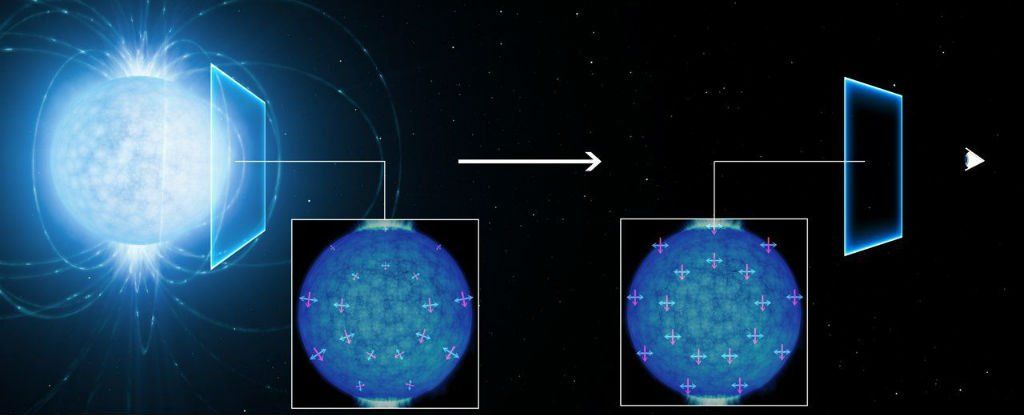Page 10783
Nov 30, 2016
We Just Got the First Real Evidence of a Strange Quantum Distortion in Empty Space
Posted by Shane Hinshaw in categories: quantum physics, space
For the first time, astronomers have observed a strange quantum phenomenon in action, where a neutron star is surrounded by a magnetic field so intense, it’s given rise to a region in empty space where matter spontaneously pops in and out of existence.
Called vacuum birefringence, this bizarre phenomenon was first predicted back in the 1930s, but had only ever been observed on the atomic scale. Now scientists have finally seen it occur in nature, and it goes against everything that Newton and Einstein had mapped out.
“This is a macroscopic manifestation of quantum field,” Jeremy Heyl from the University of British Columbia in Canada, who was not involved in the research, told Science. “It’s manifest on the scale of a neutron star.”
Nov 30, 2016
Scientists design living organisms that make chemical bonds not found in nature
Posted by Shane Hinshaw in categories: alien life, biological, chemistry
Move over, chemists. Thanks to proteins from Icelandic bacteria, scientists at Caltech have managed to coax microbes into making silicon-carbon bonds, a feat that until now has been achieved only by humans in the lab.
The findings, published last week in the journal Science, could open the door to new avenues in organic chemistry and drug development — and could help scientists investigate essential mysteries, such as whether life could be based on silicon instead of carbon on other planets.
The recently discovered element 117 has been officially named “tennessine” in recognition of Tennessee’s contributions to its discovery, including the efforts of the Department of Energy’s Oak Ridge National Laboratory and its Tennessee collaborators at Vanderbilt University and the University of Tennessee.
“The presence of tennessine on the Periodic Table is an affirmation of our state’s standing in the international scientific community, including the facilities ORNL provides to that community as well as the knowledge and expertise of the laboratory’s scientists and technicians,” ORNL Director Thom Mason said.
“The historic discovery of tennessine is emblematic of the contributions Tennessee institutions like Oak Ridge National Laboratory, the University of Tennessee and Vanderbilt University make toward a better world,” Tennessee Gov. Bill Haslam said. “On behalf of all Tennesseans we thank this world body for honoring our state this way.”
Nov 30, 2016
Team combines quantum physics and photosynthesis to make discovery that could lead to highly efficient solar cells
Posted by Shane Hinshaw in categories: biological, quantum physics, solar power, sustainability
A University of California, Riverside assistant professor has combined photosynthesis and physics to make a key discovery that could help make solar cells more efficient. The findings were recently published in the journal Nano Letters.
Nathan Gabor is focused on experimental condensed matter physics, and uses light to probe the fundamental laws of quantum mechanics. But, he got interested in photosynthesis when a question popped into his head in 2010: Why are plants green? He soon discovered that no one really knows.
During the past six years, he sought to help change that by combining his background in physics with a deep dive into biology.
Nov 30, 2016
Photons created in a superposition of two colours
Posted by Karen Hurst in categories: computing, quantum physics

The non-profits & charities supported will include the lifeboat foundation smile
Find out in a minute.
Nov 30, 2016
Geohot’s startup Comma.ai open-sources its self-driving car technology
Posted by Bruno Henrique de Souza in categories: robotics/AI, transportation
George “Geohot” Hotz is driving forward with his push to bring self-driving cars to the masses, but he’s going about it a slightly unconventional way. His company Comma.ai is brushing past some previous regulatory issues and is trying another route — open-sourcing not only its self-driving technology, but also instructions for building your very own hardware device (“a robotics platform”) called Comma Neo. All of this information is available today through Comma.ai’s GitHub repositories.
Since the beginning, the company has had a goal of being the Android version of self-driving cars — it wants to empower “ghostriding for the masses.” Earlier this year, it was approached by state and federal regulators inquiring about a product Hotz claimed wasn’t even on sale yet. Fed up with the scrutiny, Comma.ai cancelled its first product, the Comma One, and pivoted its thinking to democratizing its knowledge. So it’s keeping with its promise, but has scrapped its $999 price point in favor of it being free. “If we really want to be the Android of self-driving cars, we can’t be charging $999, can we?” Hotz explained.
Nov 30, 2016
Drugs to Extend Life — Nathaniel David, CEO of Unity Biotechnology
Posted by Steve Hill in categories: biotech/medical, life extension

Nathaniel David from Unity Biotech giving a talk about the potential of Senolytics and how science can break the natural limit to lifespan. David is the CEO of Unity Biotechnology a company taking SENS based Senolytic drugs into human clinical trials in the next year or so. Very exciting as this is the first true rejuvenation biotechnology therapy to be deployed in humans.
Unity is leading the way for the first rejuvenation technologies in the #sens model. Here we have Nathaniel David from Unity talking about the potential of Senolytics and increased lifespans.
Continue reading “Drugs to Extend Life — Nathaniel David, CEO of Unity Biotechnology” »
Nov 30, 2016
When A.I. Matures, It May Call Jürgen Schmidhuber ‘Dad’
Posted by Andreas Matt in category: robotics/AI
A researcher who co-wrote a paper in the 1990s on a crucial artificial intelligence technique feels overlooked by today’s stars in the field.















